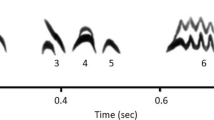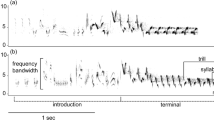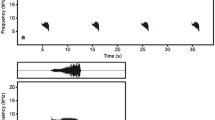Abstract
Variation in vocal behavior among local populations of songbirds may be significant to females in mate choice. In a study of dialect populations of brown-headed cowbirds, estradiol-implanted females from two dialects held the pre-copulatory lordosis posture longer in response to playback of the local flight whistle song than to foreign whistle types from adjacent and more distant dialects. Females were held in captivity for a relatively brief period prior to testing and received no tutoring so discrimination was based solely on experience in the wild. This is the first study to show evidence of discrimination by female cowbirds based on flight whistle type. Evidence is presented from one of the study dialects that the majority of yearling male cowbirds are vocally distinct from resident adults in having either foreign or incomplete local whistles. Although these yearlings are fully mature sexually, they have little or no mating success. The correlation between female whistle preference and male mating success suggests that the ability to give the correct local whistle type may be a characteristic used by females to assess age and quality of a potential mate. A learned female preference for the predominant local song type may be a factor in the stability of these dialects by making it adaptive for males to conform to the local dialect.
Similar content being viewed by others
References
Baker MC (1983) The behavioral responses of female Nuttall's white-crowned sparrows to male song of natal and alien dialects. Behav Ecol Sociobiol 12:309–315
Baker MC, Cunningham MA (1985) The biology of bird-song dialects. Behav Brain Sci 8:85–133
Baker MC, Spitler-Nabors KJ, Bradley DC (1981) Early experience determines song dialect responsiveness of female sparrows. Science 214:819–820
Baker MC, Spitler-Nabors KJ, Bradley DC (1982) The response of female mountain white-crowned sparrows to songs from their natal dialect and an alien dialect. Behav Ecol Sociobiol 10:175–179
Baker MC, Bjerke TK, Lampe H, Espmark Y (1987a) Sexual response of female yellowhammers to differences in regional song dialects and repertoire sizes. Anim Behav 35:395–401
Baker MC, Spitler-Nabors KJ, Thomson AD Jr, Cunningham MA (1987b) Reproductive behavior of female white-crowned sparrows: effect of dialects and synthetic hybrid song. Anim Behav 35:1766–1774
Balthazart J (1983) Hormonal correlates of behavior. In: Farner S, King JR, Parkes KS (eds) Avian biology, vol VII. Academic Press, New York, pp 221–236
Casey RC, Baker MC (1992) Early social tutoring influences female sexual response in white-crowned sparrows. Anim Behav 44:983–986
Catchpole CK (1987) Bird song, sexual selection, and female choice. Trends Ecol Evol 2:94–97
Chilton G, Lein MR, Baptista LF (1990) Mate choice by female white-crowned sparrows in a mixed-dialect population. Behav Ecol Sociobiol 27:223–227
Clayton NS, Pröve E (1989) Song discrimination in female zebra finches and Bengalese finches. Anim Behav 38: 352–353
Darley JA (1968) The social organization of breeding brown-headed cowbirds. PhD dissertation, University of Western Ontario, London, Canada
Dufty AM Jr (1986) Singing and the establishment and maintenance of dominance hierarchies in captive brown-headed cowbirds. Behav Ecol Sociobiol 19:49–55
Dufty AM Jr, McChrystal R (1992) Vocalizations and copulatory attempts in free-living brown-headed cowbirds. J Field Ornithol 63:16–25
Fleischer RC, Rothstein SI (1988) Known secondary contact and rapid gene flow among subspecies and dialects in the brown-headed cowbird. Evolution 42:1146–1158
Fleischer RC, Smyth AP, Rothstein SI (1987) Temporal and age-related variation in the laying rate of the parasitic brown-headed cowbird in the eastern Sierra Nevada, California. Can J Zool 65:2724–2730
Fleischer RC, Rothstein SI, Miller LS (1991) Mitochondrial DNA variation indicates gene flow across a zone of known secondary contact between two subspecies of the brown-headed cowbird. Condor 93:185–189
Greenwood PJ, Harvey HH (1982) The natal and breeding dispersal of birds. Annu Rev Ecol Syst 13:1–21
Grinnell J, Miller AH (1944) The distribution of the birds of California. Pacific Coast Avifauna 27:1–615
King AP, West MJ (1977) Species identification in the North American cowbird: appropriate responses to abnormal song. Science 195:1002–1004
King AP, West MJ (1990) Variation in species-typical behavior: a contemporary issue for comparative psychology. In: Dewsbury DA (ed) Contemporary issues in comparative psychology. Sinauer, Sunderland, pp 321–339
King AP, West MJ, Eastzer DH (1980) Song structure and song development as potential contributors to reproductive isolation in cowbirds (Molothrus cater). J Comp Physiol Psychol 94: 1028–1036
King AP, West MJ, Eastzer DH (1986) Female cowbird song perception: evidence for different developmental programs within the same subspecies. Ethology 72: 89–98
Kroodsma DE (1989) Suggested experimental designs for song playbacks. Anim Behav 37:600–609
Laskey AR (1950) Cowbird behavior. Wilson Bull 62:157–174
Lougheed SC, Handford P (1992) Vocal dialects and the structure of geographic variation in morphological and allozymic characters in the rufous-collared sparrow, Zouotrichia capensis. Evolution 46:1443–1456
O'Loghlen AL (1993) Vocal ontogeny and the maintenance of dialects in wild populations of brown-headed cowbirds. PhD dissertation, University of California, Santa Barbara
O'Loghlen AL, Rothstein SI (1993) An extreme example of delayed vocal development: song learning in a wild population of brown-headed cowbirds. Anim Behav 46:293–304
Ratcliffe L, Weisman R (1987) Phase order recognition by brown-headed cowbirds. Anim Behav 35:1260–1262
Rothstein SI, Fleischer RC (1987) Vocal dialects and their possible relation to honest status signalling in the brown-headed cowbird. Condor 89:1–23
Rothstein SI, Verner J, Stevens E (1980) Range expansion and diurnal changes in dispersion of the brown-headed cowbird in the eastern Sierra Nevada. Auk 97:253–267
Rothstein SI, Verner J, Stevens E (1984) Radio-tracking confirms a unique diurnal pattern of spatial occurrence in the parasitic brown-headed cowbird. Ecology 65:77–88
Rothstein SI, Yokel DA, Fleischer RC (1986) Social dominance, mating and spacing systems, female fecundity, and vocal dialects in captive and free ranging brown-headed cowbirds. In: Johnston RF (ed) Current ornithology, vol 3. Plenum, New York, pp 127–185
Rothstein SI, Yokel DA, Fleischer RC (1988) The agonistic and sexual functions of vocalizations of male brown-headed cowbirds, Molothrus ater. Anim Behav 36:73–86
Rothstein SI, Ortega JC, O'Loghlen AL (1989) Cowbird song. Nature 339:21–22
Searcy WA (1990) Species recognition of song by female red-winged blackbirds. Anim Behav 40:1119–1127
Searcy WA (1992) Measuring responses of female birds to male song. In: McGregor PK (ed) Playback and studies of animal communication. Plenum, New York, pp 175–198
Searcy WA, Andersson M (1986) Sexual selection and the evolution of song. Annu Rev Ecol Syst 17:507–533
Searcy WA, Brenowitz EA (1988) Sexual differences in species recognition of avian song. Nature 332:152–154
Selander RK, Giller DR (1960) First year plumages of the brown-headed cowbird and red-winged blackbird. Condor 62:202–214
Verner J, Ritter LV (1983) Current status of the brown-headed cowbird in the Sierra National Forest. Auk 100:355–368
West MJ, King AP (1989) Cowbird song. Nature 339:22
West MJ, King AP, Eastzer DH (1981) Validating the female bioassay of cowbird song: relating differences in song potency to mating success. Anim Behav 29:490–501
Yokel DA (1986a) Monogamy and brood parasitism: an unlikely pair. Anim Behav 34:1348–1358
Yokel DA (1986b) The social organization of the brown-headed cowbird in the Owens Valley, California. In: Hall CA, Young DJ (eds) Natural history of the White-Inyo Range, eastern California and western Nevada and high altitude physiology. (University of California, White Mountain Research Station Symposium, vol 1). Regents of the University of California, Los Angeles, pp 164–172
Yokel DA, Rothstein SI (1991) The basis for female choice in an avian brood parasite. Behav Ecol Sociobiol 29:39–45
Author information
Authors and Affiliations
Additional information
Communicated by G.M. Klump
Rights and permissions
About this article
Cite this article
O'Loghlen, A.L., Rothstein, S.I. Culturally correct song dialects are correlated with male age and female song preferences in wild populations of brown-headed cowbirds. Behav Ecol Sociobiol 36, 251–259 (1995). https://doi.org/10.1007/BF00165834
Received:
Accepted:
Issue Date:
DOI: https://doi.org/10.1007/BF00165834




